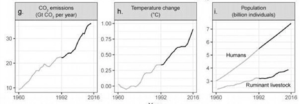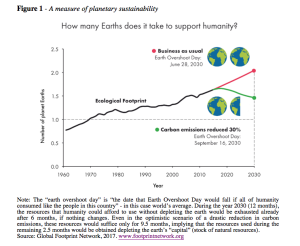In 1992 the Union of Concerned Scientists published the “World Scientists’ Warning to Humanityâ€. Twenty-five years later it has just been updated.
Most of the Nobel Prize winners then alive and 1575 senior scientists signed the original warning. It started with the words: “Human beings and the natural world are on a collision course. Human activities inflict harsh and often irreversible damage on the environment and on critical resources. If not checked, many of our current practices put at serious risk the future that we wish for human society and the plant and animal kingdoms, and may so alter the living world that it will be unable to sustain life in the manner that we know.â€
After this powerful introduction there are several headings. The heading titled “Population†states what many people (especially economists) are still denying. It starts with: “The earth is finite.â€
Later in the “Population†heading you can read: “Pressures resulting from unrestrained population growth put demands on the natural world that can overwhelm any efforts to achieve a sustainable future.†I find it remarkable that those who write about “sustainable development†so often ignore this obvious fact.
This 1992 Warning had 5 points under the title “What We Must Doâ€. Point #3 states: “We must stabilize population. This will be possible only if all nations recognize that it requires improved social and economic conditions, and the adoption of effective, voluntary family planning.†Unfortunately this was all but ignored. In fact, just 2 years later, at the UN’s International Conference on Population and Development, delegates decided to turn the focus away from population and toward HIV and reproductive rights. This had an unfortunate effect on support for family planning programs.
So much for the past. Not too many people were aware of the 1992 document, and fewer took it to heart. Scientists have updated the Warning on its 25th anniversary in a remarkable fashion. “World Scientists’ Warning to Humanity: A Second Notice†was published last month in BioScience, a well-known journal. Although eight authors appear on the title page, the total number of signatories is huge—15,364 scientists from 184 countries! It is not too late to join this elite crew if, indeed, you are a scientist. Go to http://scientistswarning.forestry.oregonstate.edu to find out more and to endorse the article. Over 3,000 people have already added their names.
The current Warning is not optimistic. Of the 9 issues treated 25 years ago, only one shows improvement. The good news is that ozone-depleting emissions (chlorofluorocarbons) are decreasing. They jeopardize the atmospheric ozone that guards us against dangerous ultraviolet radiation. The other 8 trends are all bad; these include fresh water supplies, total forest area, vertebrate species abundance and ocean dead zones. Need I also mention that the CO2 level is rising and the climate is heating up?
It comes down to two factors—population and consumption. The authors put it this way: “We are jeopardizing our future by not reining in our intense… material consumption and by not perceiving continued rapid population growth as a primary driver behind many ecological and even societal threats.â€
Slowing population growth seems much more attainable than decreasing consumption, however. So many people want to manage their fertility but don’t have access to effective contraception—we must expand access to birth control here and abroad.
There is hope. The new Warning points out that pressure on politicians, especially from scientists and concerned citizens, can create change. The authors also cite the importance of changing individual behaviors such as choosing to have small families and to consume less—including moving toward a plant-based diet. They celebrate the decrease in family size throughout most of the world and praise the decrease in world hunger. They use the example of the decrease in chlorofluorocarbons as an example of what can be done when there is political will.
The Warning gives 13 steps to take in order to move in the correct direction to save our life support systems. The 12th is to revise our economy to reduce inequality of wealth and to take into account the externalities that harm our planet. The last proposes a revolutionary idea—to determine what a long-term sustainable human population might be, then to rally support to reach that goal.
Can more than 18,000 scientists make a difference in a positive direction? We have seen how much damage one person, the president of the USA, can do by moving us away from sustainability. It is time for us to heed the far-sighted Warning for our progeny’s sake.
© Richard Grossman MD, 2017

